What Are Limiting Beliefs?
Written By Tiffany Woodfield, Financial Coach, TEP®, CRPC®, CIM®
Limiting beliefs are deeply ingrained, negative, or fear-driven thoughts or convictions that you hold about yourself or the world. They restrict your potential by creating self-imposed barriers.
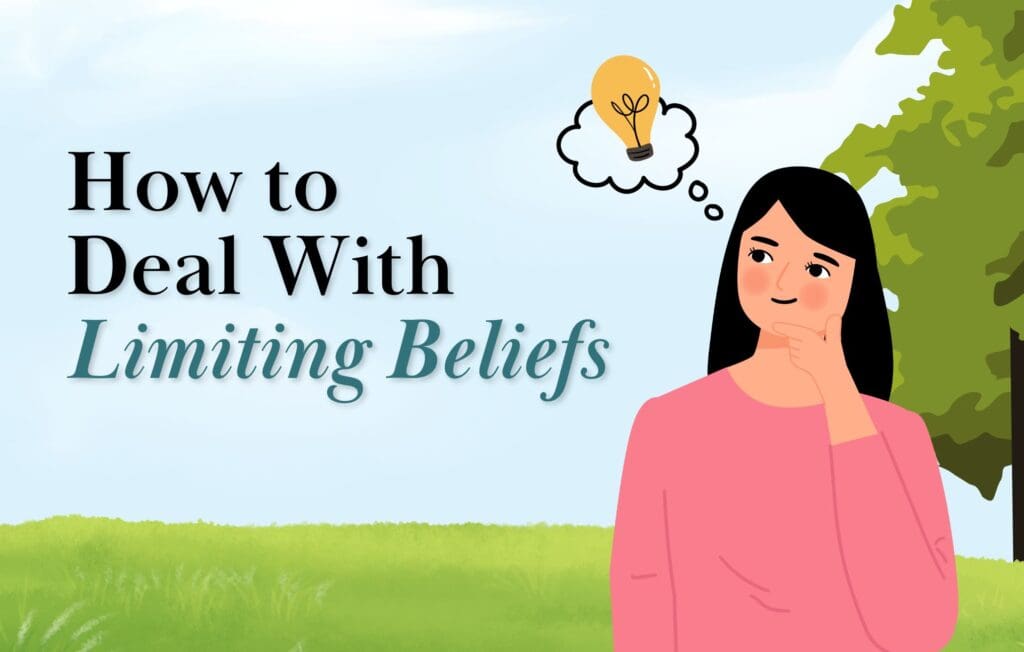
They’re like invisible walls that can hold you back from achieving your goals or reaching your true potential.
Limiting beliefs often stem from childhood experiences, social conditioning, or other painful events in the past. They can manifest as subconscious assumptions about your abilities, worth, or the nature of the world.
Limiting beliefs usually run deep in the background, often without us consciously noticing. You might think, “I can’t do that,” or “You’re not allowed to do that,” or “You’re going to fail.”
These thoughts can appear out of nowhere, stopping you from taking action.
The key to overcoming these thought patterns is to notice them. Cultivate awareness through meditation and journaling so you can hear the limiting belief when it starts to run in the background.
Start challenging your limiting beliefs and ask yourself if they are really true. Next, ask yourself what could be true instead. Seek to reframe the belief into something more expansive and helpful.
Eventually, as you work on noticing and shifting your limiting beliefs, they will become less powerful. In tandem, your ability to achieve your goals and improve your skills will grow exponentially.
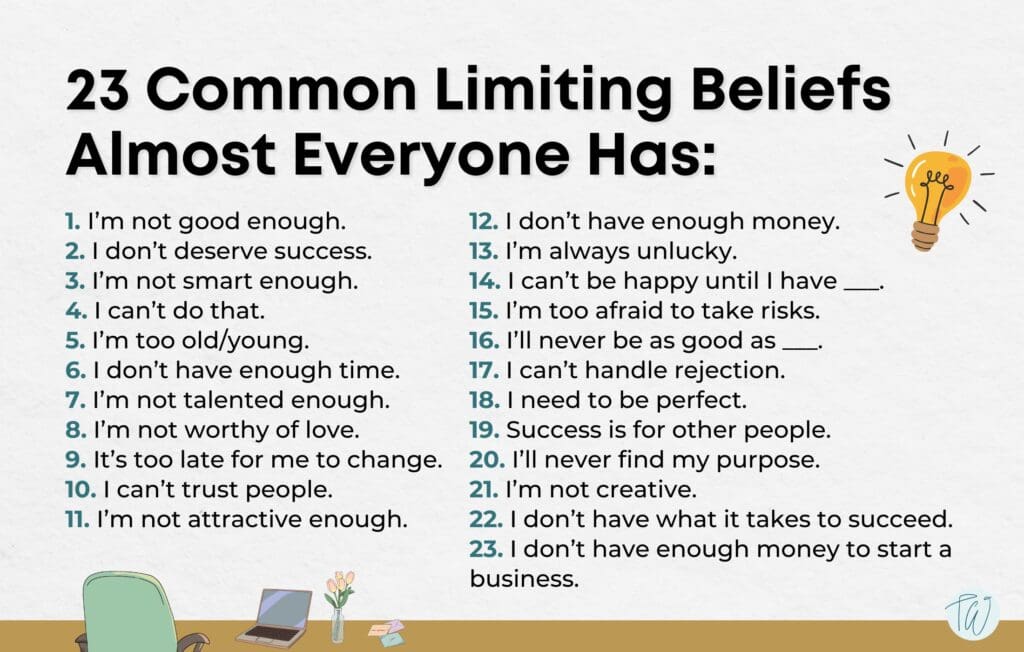
Many of us struggle with limiting beliefs.
You’re not alone if you’ve ever felt stuck or held back by your thoughts.
But limiting beliefs can get in the way of personal and professional growth, so it’s important we work to overcome them.
In this blog, I’m going to explore limiting beliefs and how they impact your life. I’ll give you practical advice to help you identify and get over them. Understanding and addressing your limiting beliefs can help you change your mindset and unlock your potential.
I know how powerful overcoming limiting beliefs can be because I’ve done it!
Read this full post for a ton of examples of limiting beliefs and exactly how you can overcome your limiting beliefs.
Table of Contents
- My Story of Overcoming Limiting Beliefs
- Take the Limiting Beliefs Quiz
- What Is a Limiting Belief?
- What Are the Causes of Limiting Beliefs?
- How Limiting Beliefs Impact Success
- Identifying Your Limiting Beliefs
- Try This Simple 5-step Process for Overcoming Any Limiting Belief
- Overcoming Limiting Beliefs with Coaching or Self-Reflection
- Limiting Beliefs By Category
- Why Believing in Yourself Is Important
- How Visualizing Best-Case Scenarios Can Help
- Overcoming Limiting Beliefs in the Workplace
- The Science Behind Limiting Beliefs
- Practical Exercise to Challenge Limiting Beliefs
- Common Questions about Limiting Beliefs
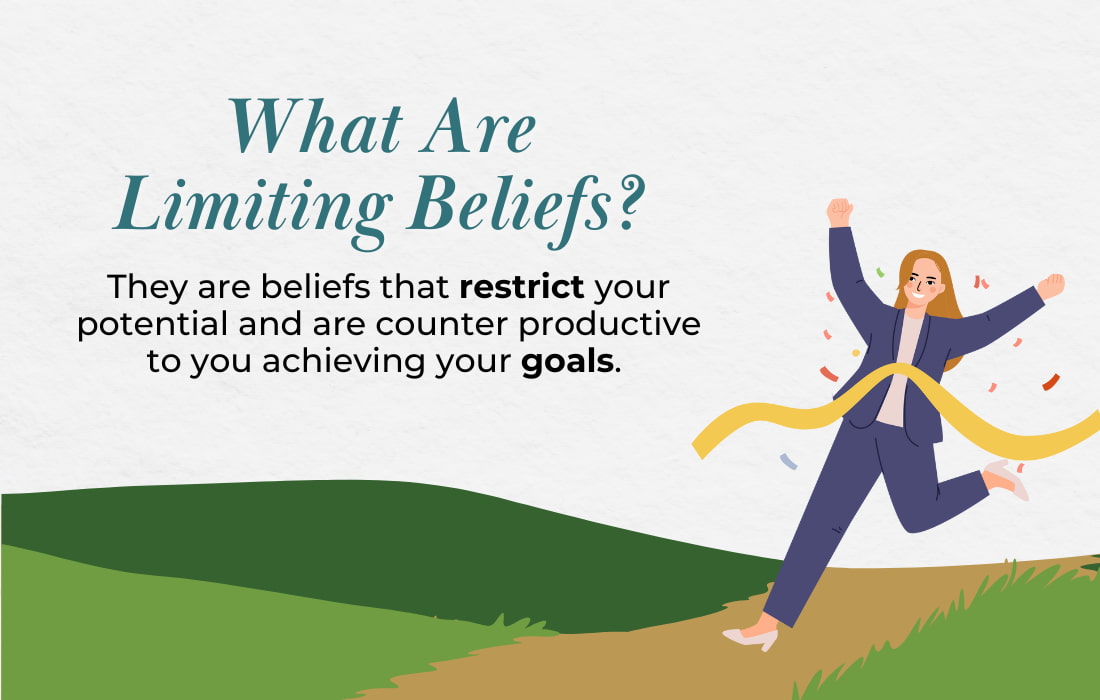
Summary of Key Points
- Limiting beliefs are negative thoughts that hold you back
- They stem from childhood experiences and social conditioning
- To reprogram your limiting beliefs, start by noticing them
- Shift your limiting beliefs to positive ones by challenging them consistently
- As you replace your limiting beliefs, your ability to succeed will expand
- Life becomes more enjoyable when you’re less limited by negative thought patterns
Here’s How I Started to Overcome My Limiting Beliefs
I’ve been obsessed with the concept of limiting beliefs since I was a kid.
I would observe how different people would react to the same situation. I was curious why some people seemed programmed to respond a certain way while others were not.
I didn’t know the concept of “limiting beliefs,” but I could recognize patterns in people’s reactions based on their life experiences.
It wasn’t until I started meditating that I understood my own limiting beliefs. I quieted my mind and started to observe my thoughts.
It made me intensely curious. During the day, I would “listen” to my thoughts and judgements of certain situations and people. For example, I would see someone who was very successful and had started a company and think, “They are creative and intelligent; I could never do that.”
I would catch myself wanting to create wealth and instantly think, “Don’t you have enough?” or “You’re so selfish for wanting more when so many others have so little.”
It’s scary to think that I wasn’t aware of these limiting beliefs and their power over me until I learned to observe my thoughts. How could I work towards creating my vision when, in the back of my mind, I was telling myself it was selfish to want more. And even worse, how much damage was I doing by telling myself that I wasn’t smart enough?
I made it my mission to overcome my limiting beliefs.
I created a strategy where I acknowledged my limiting beliefs and wrote them down.
I questioned whether each limiting belief was 100% true.
For example, I asked myself, “Is it 100% true that I’m selfish for wanting more?”
I then thought of situations where, by creating something of value, I would be helping others. I worked on positive affirmations and visualizations to train my brain to think positively.
With particularly stubborn limiting beliefs, I would think of what I would say to a friend if they told me they were thinking these things about themselves.
This “workaround” helped me see how harshly I was judging myself.
Look, if you don’t release your limiting beliefs, it’s like trying to drive with the parking brake on. You’re making the road and your life a struggle. And it’s difficult to achieve any results.
Once you have overcome your limiting beliefs, you can live a fulfilling and joyful life!
Take the limiting beliefs quiz to see how you’re doing!
Take the Limiting Beliefs Quiz
Combine Manifesting and Releasing Limiting Beliefs
Manifesting is a way to bring a vision into reality. In this video I cover three manifesting tips that will help you as long as you also start to release negative beliefs that are holding you back. If you want to start achieving your goals more effectively, combine manifesting with working on your belief system.
How Does a Limiting Belief Restrict You?
A limiting belief is a belief that restricts your potential and is counterproductive to you achieving your goals.
It’s like a barrier holding you back and can occur in all areas of life, such as money, relationships, health and success.
For example, say you wanted to lose weight. You set this intention and have a little angel on your shoulder saying, “Yay! You can do anything!”
But on the other shoulder is the evil twin saying, “Who do you think you are? You are lazy and will never be successful.”
They conflict, and the limiting belief holds you back.
Limiting beliefs are like lenses through which you view yourself, society, and others. For example, when you say, “That person is selfish because they have money,” it reflects your view of money and yourself. You are just transferring the beliefs you have about yourself to another person.
6 Common Limiting Beliefs Examples with Empowering Reframes
| Category | Limiting Belief | Empowering Reframe |
|---|---|---|
| Money | “I don’t deserve to be wealthy.” | “My success can benefit others.” |
| Life | “Life is hard.” | “Life brings challenges and opportunities for growth.” |
| The World | “People are just out for themselves.” | “Many people are kind and generous.” |
| Happiness | “I don’t deserve happiness.” | “I am worthy of joy and peace.” |
| Love | “I’m difficult and not lovable.” | “I am lovable just as I am.” |
| Self | “I’m not good enough.” | “I am always learning and growing.” |
What Are the Causes of Limiting Beliefs?
Limiting beliefs are rooted in your past experiences.
This may be directly from your family, societal influences, or the era in which you grew up. For example, my husband’s parents grew up in Britain during the Second World War.
Because many goods were scarce under rationing regulations, his parents never recovered and always had a “lack mentality.”
They lived in constant fear of never having enough, which became a burden they carried around daily, impacting their health and happiness.
Studies Show that Limiting Beliefs Aren’t Based In Reality
One way that limiting beliefs can take over our daily lives is through worry.
Incessantly worrying about unlikely outcomes is a form of limiting yourself. You may even have a limiting belief that says, “By worrying, I help prepare for the worst.” This belief gives you a reason to keep worrying. But research shows that worry isn’t particularly productive.
In one study, people with generalized anxiety disorder tracked their worries for two weeks.
It turned out that only 15% of the things they worried about actually happened, and even when things did go wrong, they coped better than they expected nearly 80% of the time (Borkovec, Hazlett-Stevens, & Diaz, 1999).
Put another way, only 85% of their worries were based in reality.
Another study found an even higher number—over 91% of worries never came true at all.
In fact, in this study the more people realized how often their worries were inaccurate, the more they improved during treatment (LaFreniere & Newman, 2020).
This is an important and research-backed reminder that our anxious thoughts (aka. limiting beliefs) aren’t facts. And believing them can hold us back!
Source: Exposing Worry’s Deceit: Percentage of Untrue Worries in Generalized Anxiety Disorder Treatment
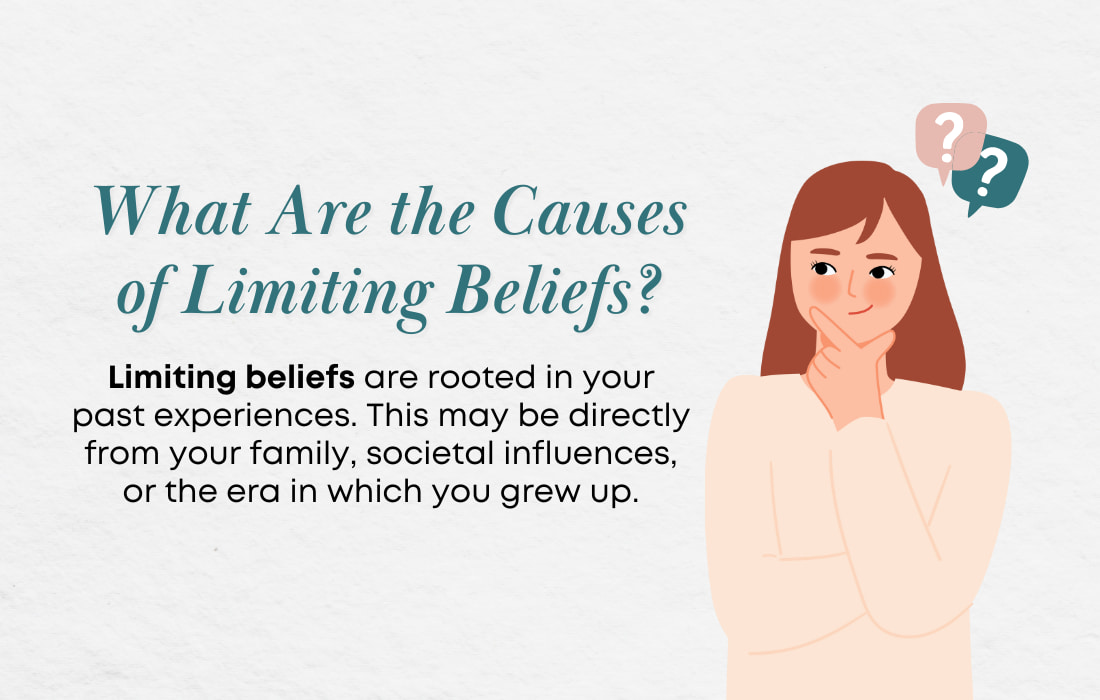
How Limiting Beliefs Impact Success
One of the most crucial indicators that someone will become successful is their mindset.
You must believe in yourself and your ability. You have to be willing to adapt, change, and get uncomfortable.
Limiting beliefs are contractionary and hold you back because they don’t align with success, expansion and growth. Your subconscious mind is programmed to keep you safe, which means keeping things the same and not challenging your comfort zone.
To grow and succeed, you must face your fears and decide to go forward.
Identifying Your Limiting Beliefs
If you’ve come this far, you may want to identify limiting beliefs so that you can release them.
But this can be tricky. Below are some of the most common limiting beliefs. See if any of these limiting beliefs resonate with you then try out the step-by-step process for releasing limiting beliefs.
23 Self-Limiting Beliefs Almost Everyone Has
Read through this list of common limiting beliefs to see if you hold any of these thoughts about yourself or the world. Or take the quiz.
- I’m not good enough.
- I don’t deserve success.
- I’m not smart enough.
- I can’t do that.
- I’m too old/young.
- I don’t have enough time.
- I’m not talented enough.
- I’m not worthy of love.
- It’s too late for me to change.
- I can’t trust people.
- I’m not attractive enough.
- I don’t have enough money.
- I’m always unlucky.
- I can’t be happy until I have ___.
- I’m too afraid to take risks.
- I’ll never be as good as ___.
- I can’t handle rejection.
- I need to be perfect.
- Success is for other people.
- I’ll never find my purpose.
- I’m not creative.
- I don’t have what it takes to succeed.
- I don’t have enough money to start a business.
You may ask yourself, “How can I recognize my limiting beliefs?”
The easiest way is to listen to your judgements and negative self-talk. Limiting beliefs may sound like reasons in your head, but if you are honest, they are really excuses.
A quick tip: When you recognize a limiting belief in a particular situation, ask yourself if you would have this same judgment you had of yourself about a good friend in the same situation.
When you externalize the limiting beliefs and see if you would apply them to people you love, it can help you see that they are not true and thus not valid.
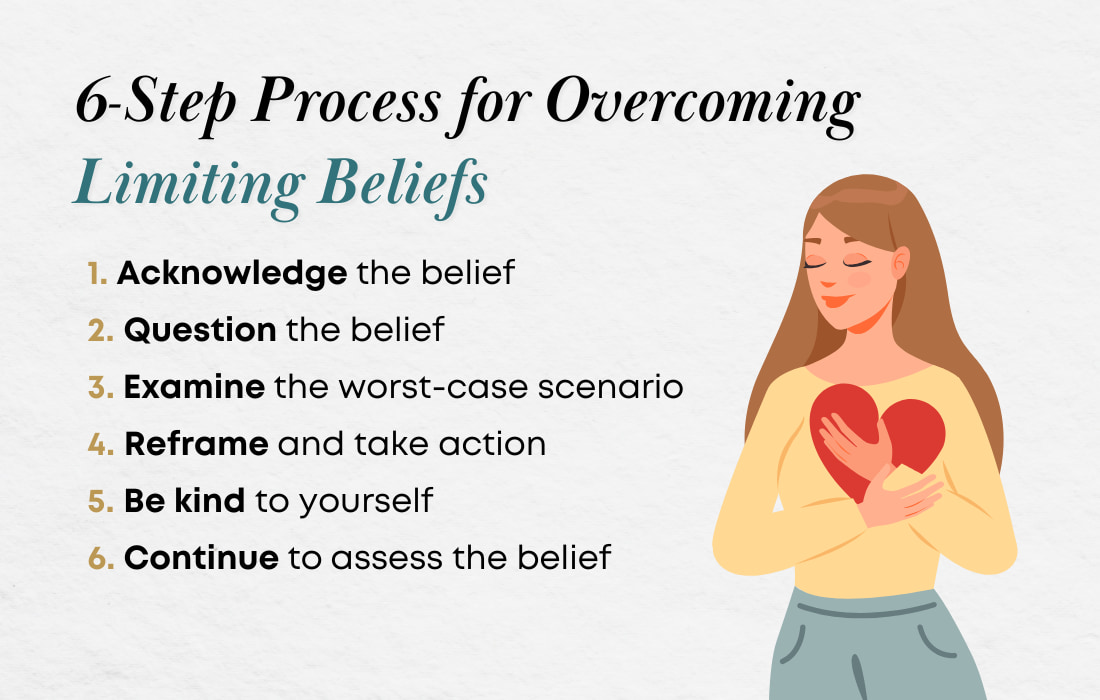
Try This Simple 6-step Process for Overcoming Any Limiting Belief
Step 1: Acknowledge the Limiting Belief
- The first step in overcoming any limiting belief is to recognize it.
- Ask yourself, “What belief is holding me back?”
- Simply acknowledging the belief starts to weaken its control over you.
Step 2: Question the Belief
- Once you’ve identified the limiting belief, ask, “Is this belief true?”
- Challenge the belief by finding evidence where it doesn’t hold up.
- Reflect on where this belief came from—often, it’s based on past experiences or assumptions, not facts.
- Ask yourself how strongly you believe it to be true. Observe your conviction as a percentage. Are you 100% convinced that it’s true? Are you 50% convinced that it’s true?
Step 3: Examine the Worst-Case Scenario
- Think about the fear behind the belief: What is the worst that could happen if you take the action you’re avoiding?
- By visualizing the worst-case scenario, you often realize it’s not as bad as it seems.
- Compare the cost of not taking action with the fear of what could happen if you do.
Step 4: Reframe and Take Action
- Reframe the belief into something empowering. For example, change “I’m not good enough” to “I am capable of learning and growing.”
- Visualize yourself taking that small, courageous step forward.
- Take one small action, even if it feels uncomfortable—this builds momentum and confidence.
Step 5: Be Kind to Yourself
- Treat yourself with the same compassion you’d offer a friend.
- Comfort yourself by acknowledging that everyone has insecurities.
- Remind yourself that you can handle challenges as they come.
- Keep focusing on the positive feelings that come with progress, no matter how small.
By following these steps, you can begin to break free from limiting beliefs and move towards your goals with more confidence.
Step 6: Continue to Assess the Limiting Belief Until It’s Gone
- Watch to see where the limiting belief comes up in daily life.
- Ask yourself how strongly you believe it to be true. Observe your conviction as a percentage. Does the conviction go down?
- Continue to question the belief until it’s gone.
By following these steps, you can begin to break free from limiting beliefs and move more confidently toward your goals.
Overcoming Limiting Beliefs with Coaching or Self-Reflection
Change is uncomfortable, and you are charting new territory.
To make any change happen, whether it’s losing weight, quitting a bad habit, or, in this case, overcoming limiting beliefs, having a coach to keep you accountable and on track will increase your success exponentially. I personally work with a coach and have found the experience to be valuable.
What Are Some Common Limiting Beliefs Examples?
Limiting Beliefs Examples By Category
There are millions of limiting beliefs that a person could hold.
Let’s break it down some examples by category to see if you have more limiting beliefs in a particular area.
Limiting Beliefs About Money:
- Wanting more money is evil.
- Money makes people selfish.
- There is only so much money to go around.
- I don’t deserve to be wealthy.
- I’ll never be able to make more money.
- I’ll never get out of debt.
- Money doesn’t make you happier.
- I’m too poor.
Limiting Beliefs About Life:
- I grew up in the wrong time.
- I don’t have the right connections.
- My background holds me back.
- The world is evil, and so are the people in it.
- Life is hard.
- It’s not worth trying.
- I don’t believe in good things.
Limiting Beliefs About the World:
- Society is messed up.
- There is no good out there.
- People are just out for themselves.
- Corporations want to destroy the environment.
- This is the worst time to grow up in.
- Just living each day is hard.
Limiting Beliefs About Happiness:
- Happy people aren’t as intelligent.
- Happiness is a selfish goal.
- I don’t deserve happiness because I’m ___.
- I don’t know what I want.
- I don’t think I’m special.
- I already have too much going on and don’t have time.
- I should be further ahead than I am.
- I’m a failure.
Limiting Beliefs About Love:
- I don’t deserve special attention.
- I don’t deserve love.
- I’m ugly.
- I’m difficult and not lovable.
- I don’t need a relationship.
- Relationships just cause headaches.
- If I reach out, I will be rejected.
Limiting Beliefs About Yourself:
- I’m broken inside.
- It’s too late for me.
- I’m not good at anything.
- I have never done anything well.
- I’m too scared.
- I’m not special.
- It’s harder for me than ___.
- Something is wrong with me.
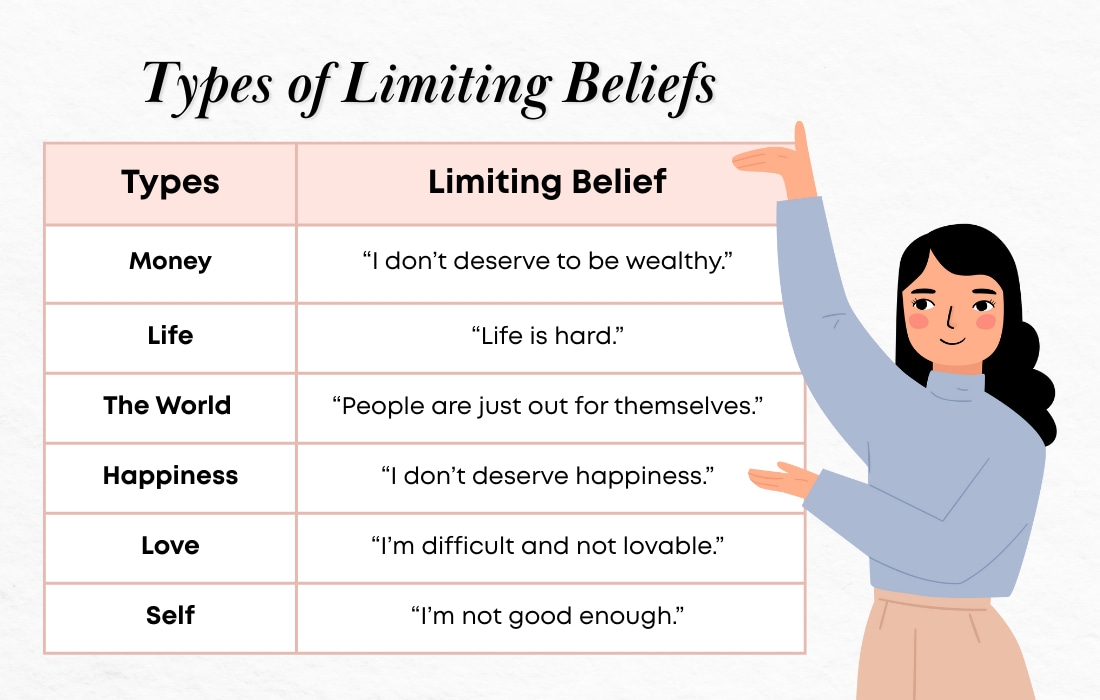
Why Believing in Yourself Is Important
It’s important to appreciate everyone has self-doubt and moments of fear.
We all have circumstances we need to face, and nobody feels ready or perfect. The difference between those who create the life they want and those who don’t is the ability to believe in yourself and that you deserve happiness.
Without strategies to build your confidence, you’ll stay where you are. You can’t wait to feel comfortable or ready, as this won’t just magically happen.
When you believe in yourself, you become your own best friend. Let that voice inside be positive and supportive, telling you what you can do rather than what you can’t.
How Visualizing Best-Case Scenarios Can Help
Visualization is a practical tool to address limiting beliefs because it gives you a clear, positive picture of what you want to achieve and keeps you motivated.
Step 1: Acknowledge the Limiting Belief
- Start by recognizing the limiting belief you want to overcome. For example, “I will never have enough money.”
- Simply acknowledging the belief is the first step toward weakening its influence.
Step 2: Visualize the Opposite of the Limiting Belief
- Picture yourself experiencing the opposite of your limiting belief. In this example, visualize having enough money to do what you want.
- Focus on the feeling that this abundance creates. Personalize it—what does having enough money mean to you?
- For example, if having enough money would allow you to take a dream vacation, picture yourself enjoying that holiday.
- Visualize the details: feel your toes in the sand, hear the sound of the surf, and immerse yourself in the experience.
- Make the visualization real by reinforcing it in your environment. For example, cut out a picture of your dream destination and place it somewhere you see every day, like next to your bed.
Step 3: Question the Limiting Belief
- Ask yourself, “Is it 100% true that I’ll never have enough money?”
- Explore ways to challenge this belief. Could you cut back on spending? Could you find ways to earn more? Research how much your goal (e.g., the trip) would actually cost, and focus on the steps you can take to make it happen.
Step 4: Reinforce the Visualization Daily
- Repeat the visualization and affirmations regularly to strengthen your belief that you can achieve your goal.
- The more you practice visualizing and challenging your unhelpful beliefs, the more real the possibility of success becomes.
Step 5: Be Patient with the Process
- Be patient and keep going.
- It may feel difficult or even impossible to overcome a limiting belief at first. However, the more you challenge these thoughts and visualize positive outcomes, the closer you’ll be to achieving your goals.
By following these steps and consistently visualizing best-case scenarios, you can shift your mindset and start turning your goals into reality.
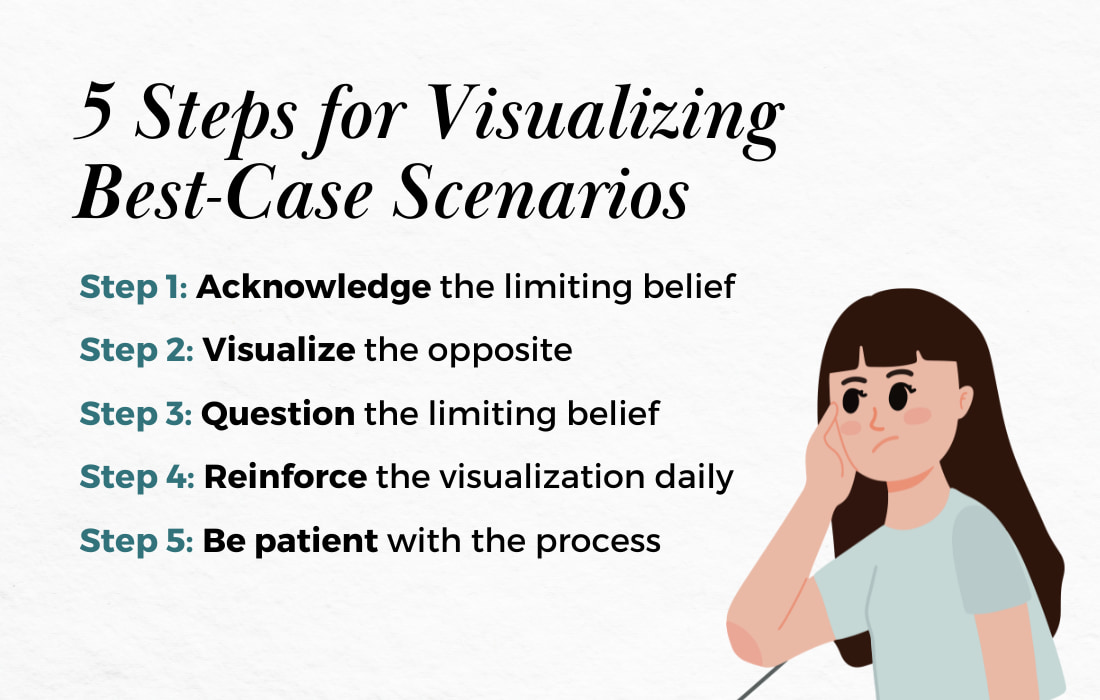
Overcoming Limiting Beliefs in the Workplace
It’s common to have limiting beliefs that affect your professional performance. I’ve listed some of the common ones below:
- I’m not smart enough to speak up with my ideas
- People will laugh at me.
- I haven’t been here long enough to get a raise or promotion.
- I have been out of the workforce for too long
- I’m worried if I get a job, I will just work all the time
- What if I fail?
To overcome these limiting beliefs, follow the steps I’ve outlined above. Here’s an example of overcoming the limiting belief, “I’m not smart enough to speak up with my ideas.”
Workplace Example: “I’m not smart enough to speak up with my ideas.”
Acknowledge the Limiting Belief
- The first step is to acknowledge that you’re holding onto the belief, “I’m not smart enough to speak up with my ideas.”
- Recognize that this belief is limiting your potential and preventing you from contributing in ways that could benefit both you and your team.
Visualize the Opposite of the Limiting Belief
- Picture yourself confidently sharing your ideas during a meeting. Visualize people nodding along, engaging with your ideas, and valuing your input.
- Focus on the positive feeling this creates—pride in contributing to your workplace, excitement from seeing your ideas take shape, and the respect you gain from your peers.
- Personalize this visualization. What would it mean for you if your ideas were recognized and appreciated? Maybe it leads to a new project, a promotion, or simply more confidence in meetings.
Question the Limiting Belief
- Ask yourself, “Is it true that I’m not smart enough to speak up?”
- Look for evidence that challenges this belief. Have you ever shared an idea that was well-received? Have you seen colleagues speak up with ideas that weren’t perfect but still added value? Remember, no one has all the answers, and your unique perspective is valuable.
Examine the Worst-Case Scenario
- Think about the worst-case scenario if you share your idea. What if people don’t like it or don’t respond positively?
- Even in the worst case, you’ll be okay. You won’t lose your job, and it’s unlikely that anyone will laugh at you. Plus, if you don’t speak up, you’ll never know what impact your ideas could have. Not taking action might cost you opportunities for growth and recognition.
Reinforce the Visualization and Take Action
- Be kind to yourself and remember that everyone feels insecure at times. Visualize yourself taking that step forward and speaking up in a meeting.
- Each time you practice this visualization and positive reinforcement, it gets easier to take action. You’ll start to feel more comfortable and confident in sharing your ideas, knowing that you’re capable of handling whatever comes your way.
By following this process, you can gradually overcome the limiting belief that you’re not smart enough to share your ideas and start contributing in ways that benefit both you and your workplace.
The Science Behind Limiting Beliefs
For centuries, people believed the brain could only form new connections when a child was young.
However, it has been proven that the brain can change throughout our lives due to intrinsic or extrinsic stimuli. Science has shown that even as an adult, you can rewire your brain to think differently. You don’t need these limiting beliefs to hold you back; you can change them to be positive.
Our ability to rewire our brains is called neuroplasticity.
According to Physiopedia, “Neuroplasticity refers to the lifelong capacity of the brain to change and rewire itself in response to the stimulation of learning and experience. Neurogenesis is the ability to create new neurons and connections between neurons throughout a lifetime. As we age, the rate of change in the brain, or neuroplasticity, declines but does not come to a halt. In addition, we now know that new neurons can appear in certain parts of the brain up until the day we die.”
This information alone shows us that we do not have to stay stuck. We can change who we are and how we perform at any age.
Practical Exercise to Challenge Limiting Beliefs
Follow this exercise to challenge any beliefs that aren’t helpful to you:
- Acknowledge the limiting belief: ” I don’t have enough time to change.”
- Assess the percentage you believe this to be accurate: 100%, 80%, 50%, etc.
- Challenge this by asking whether you can look at this another way.
Are you using all your time during the day wisely?
Do you scroll social media?
When do you waste time during the day? - Be curious: if someone else said they don’t have time and you wanted to help them, what would you say?
- Be accountable by saying, “I didn’t make time today to…” It’s a step towards change.
- Create a routine and dedicate 10 minutes daily to challenge your unhelpful beliefs.
- Track your progress using visualization, positive affirmations, meditation, and journaling tools. Find what is easy for you to follow.
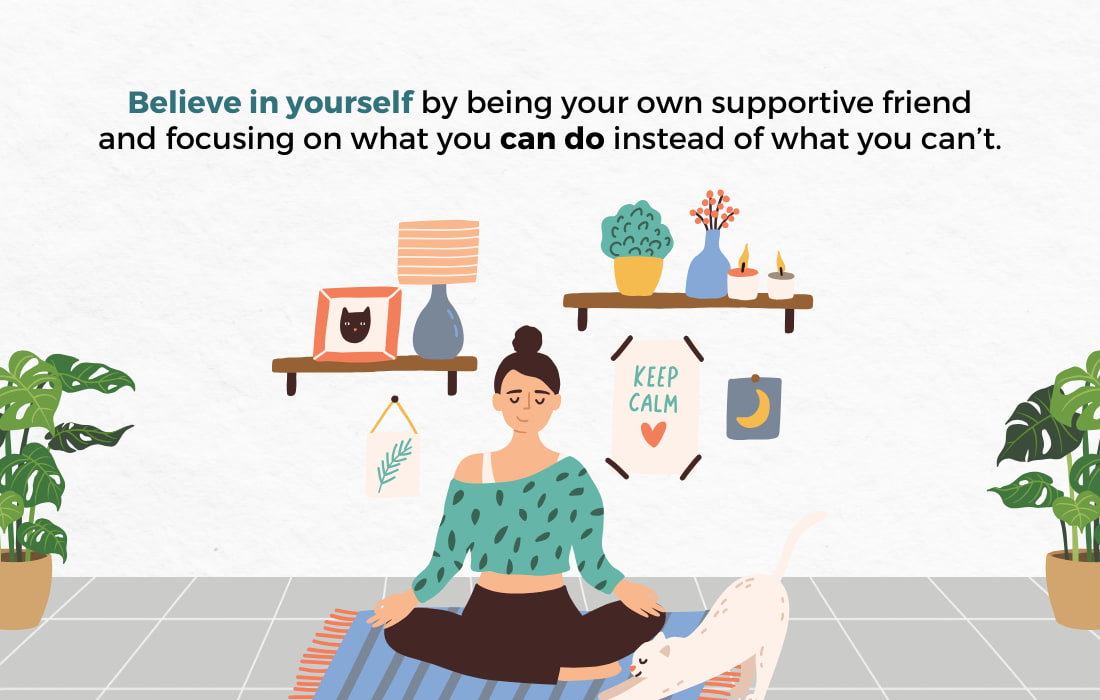
Common Questions about Limiting Beliefs
What are some examples of limiting beliefs about money that even the rich have?
- I’m selfish because I have money.
- I will never have enough money.
- I have to be careful as I could lose the money anytime.
- Money makes me better than others.
What is the best step I can take to let go of limiting beliefs?
Acknowledging the limiting belief and questioning whether it’s true. We can’t change what we aren’t aware of.
What are self-limiting beliefs? Are they different from limiting beliefs?
Self-limiting beliefs are negative thoughts or assumptions we hold about ourselves that keep us from reaching our full potential.
These are specific to how we view our abilities, worth, or capacity for success. For example, thoughts like “I’m not smart enough” or “I can’t handle this” are self-limiting beliefs.
While limiting beliefs can be broader and apply to general views about the world or other people, Self-limiting beliefs are focused directly on what we think we are capable of. Both types of beliefs can hold us back.
In short, self-limiting beliefs are a type of limiting belief that is just more personal!
Can positive affirmations help me overcome limiting beliefs?
Positive affirmations can help you overcome negative beliefs, especially when you create a positive affirmation that directly addresses the limiting thought.
What is the best way to combat limiting beliefs?
The best way to combat limiting beliefs is to acknowledge and identify your limiting beliefs.
Think of it as shining a light on the messages you are telling yourself. Only then can you take proactive steps to prevent them from limiting you.
Can positive thinking help me release a limiting belief?
Yes, positive thinking is a successful strategy that allows you to turn negative self-talk into positive beliefs. You are rewiring your brain to think positively.
How can I increase self-awareness?
To increase self-awareness, create a practice where you spend quality quiet time, such as meditation. Even 10 minutes a day can have a significant impact on your life.
Are limiting beliefs the same thing as negative thoughts?
Limiting beliefs are negative thoughts directed at how you view yourself, others, and society. When you have a negative thought, it’s based on your limiting beliefs.
Do limiting beliefs affect your self-esteem?
Yes, they keep you in a negative state of mind and limit your potential to believe in yourself.
This, in turn, reduces your confidence and holds you back from pursuing new life experiences and opportunities.
Are limiting beliefs defense mechanisms?
Your subconscious is designed to protect you; therefore, limited beliefs can act as defense mechanisms to prevent you from getting hurt.
This is especially true when your subconscious remembers past negative experiences.
Final Thoughts
The key to overcoming your limiting beliefs is to identify them.
Why? Because if you don’t know what’s holding you back subconsciously, it will be impossible to change. The first step to take when working to let go of any belief that is holding you back to is write down every single belief that you think might be holding you back. Ask yourself how much you believe it one to be true.
Then come up with alternative beliefs that are more helpful. Next, make sure you watch for negative thought patterns throughout the day and shift any negative or unhelpful thoughts as they surface.
Mediation and journalling are helpful when it comes to overcoming your self-limiting beliefs. And, of course, time. It does take time and consistent practice to release old thought patterns. Just stick with it. I know that you can overcome any self-limiting beliefs you’re holding because I’ve done it myself.
So just keep going!
Get the Free Guide and Audio Meditation for Manifesting Your Dreams
Pop your email address in the form below to get my easy checklist and guide to manifesting and the guided audio meditation to help you get started.
You’ll also get one or two emails per month with the latest blog posts about abundance, wealth-building, manifesting, and creating a fulfilling life.
Related Articles
💎 80+ Positive Affirmations for Women
💎 How to Change Your Mindset on Making Money
💎 Who Needs Financial Coaching?
About the Author

TIFFANY WOODFIELD is a financial coach, cross-border expert, and the co-founder of SWAN Wealth based out of Kelowna, BC. As a TEP and associate portfolio manager, Tiffany has extensive experience working with successful professionals who want to leave a legacy and enjoy an adventurous, work-optional lifestyle. Tiffany combines extensive knowledge from her background as a financial professional with coaching and her passion for personal development to help her clients create a unique path that allows them to live their fullest potential. Tiffany has been a regular contributor to Bloomberg TV and has been interviewed by national and international publications, including the Globe and Mail and Barron’s.
References:
- Borkovec, T. D., Hazlett‐Stevens, H., & Diaz, M. L. (1999). The role of positive beliefs about worry in generalized anxiety disorder and its treatment. Clinical Psychology & Psychotherapy, 6(2), 126–138.
- LaFreniere, L. S., & Newman, M. G. (2020). Exposing worry’s deceit: Percentage of untrue worries in generalized anxiety disorder treatment. Behavior Therapy, 51(3), 413–423.